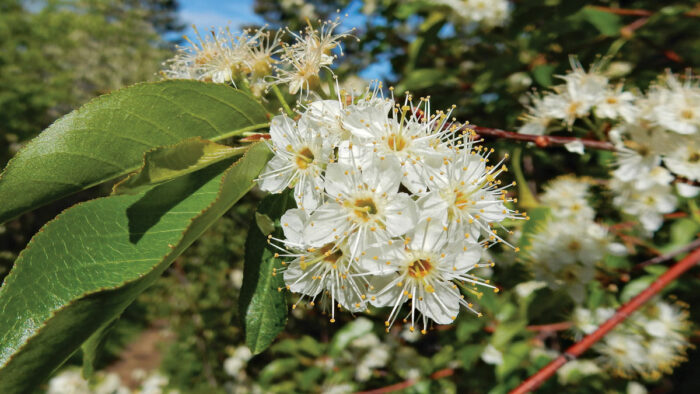
As William Cullina mentions in his article on plants for birds, the sad reality is songbirds are disappearing: “Habitat loss, pesticides, and the accompanying decline of insect populations have contributed to a loss of 25 to 30 percent of North American songbirds since 1970.”
But gardeners can help, and it just requires buying new plants! By growing more plants that help support local bird populations, you can do your part. Find plants for birds in the Mountain West below, and discover even more plants for birds in William’s article, Native Plants for the Birds.
1. ‘Furman’s Red’ Autumn Sage

Name: Salvia greggii ‘Furman’s Red’
Zones: 6–9
Size: 2 to 3 feet tall and wide
Conditions: Full sun; dry to average, well-drained soil with no fertilizer
Native range: West and Central Texas, northern Mexico
If watching and attracting hummingbirds is important to you, this is a must-have subshrub. In Boise, my plants start blooming as early as late May and will put on a show until the hardest frost in November. While autumn sage comes in several colors, I have had the best luck with ‘Furman’s Red’. Apparently the hummers are attracted to its fire engine red color as well as the tubular flower throats that hold the nectar. Planting a cluster of the same variety will provide them with an abundance of nectar all in one place.
2. Netleaf Hackberry

Name: Celtis laevigata var. reticulata
Zones: 6–9
Size: 10 to 20 feet wide and 20 to 40 feet tall
Conditions: Full sun to partial shade; average to dry, well-drained soil
Native range: The driest parts of eastern Washington and Oregon, Idaho, south to northern Mexico
This is one tough shrub, known to spring forth from rock outcroppings after scorching wildfires. The band-tailed pigeon, Steller’s jay, northern flicker, American robin, Bohemian and cedar waxwings, American crow, and towhees are just a few of the birds who rely on its persistent drupes, which can be green, orange, or red. My botany professor called the insect-created galls on its leathery leaves “burritos for wild turkeys.” Netleaf hackberry provides cover for quail and nesting sites for Swainson’s hawks, Bullock’s orioles, doves, and even the occasional hummingbird (pictured).
3. Bitter Cherry

Name: Prunus emarginata
Zones: 5–9
Size: 20 to 40 feet tall and wide
Conditions: Full sun to partial shade; moist to wet soil
Native range: Northernmost parts of British Columbia, south to New Mexico
Bitter cherry is a small deciduous shrub that can also grow up to 40 feet tall and wide in ideal conditions. It often spreads by runners creating thickets, which provide shelter and nesting places for birds and small mammals. Its springtime blossoms are a nectar source for hummingbirds and honeybees, and the shrub hosts as many as 150 types of caterpillars and insects, providing much-needed food for wild birds. The drupes are extremely bitter, but cedar waxwings, thrushes, woodpeckers, sparrows, bluebirds, tanagers, and orioles will feast on them. Bitter cherry is especially important as a roosting spot and escape haven for sharp-tailed grouse.
4. Heritage River Birch

Name: Betula nigra ‘Cully’
Zones: 4–9
Size: 40 to 70 feet tall and 40 to 60 feet wide
Conditions: Full sun to partial shade; average to wet soil
Native range: Eastern United States
This shade tree, beloved for its graceful stature and handsome peeling bark, is widely adapted across the United States. It can support more than 400 types of caterpillars and other insects, the key ingredients in baby birds’ diets. In his book Bringing Nature Home, Doug Tallamy cites the river birch as one of the top five trees for attracting wildlife. While chickadees, song sparrows, wild turkeys, pine siskins, and finches dine on the seeds, others are attracted to the sap. Chickadees, jays, juncos, northern flickers, and pine siskins may build their nests in its branches. Supplemental watering may be necessary in hot parts of the Rockies.
Mary Ann Newcomer is a native Idahoan who gardens, scouts gardens, and writes about gardening in the Intermountain West.
Fine Gardening Recommended Products

DeWalt Variable-Speed Cordless Reciprocating Saw with 6-Piece Saw Blade Set

Nelson Multi-Pattern Stationary Sprinkler

DeWalt Variable-Speed Cordless Reciprocating Saw


















Comments
Log in or create an account to post a comment.
Sign up Log in